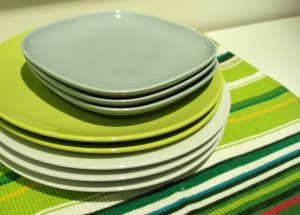 Selecting dinnerware for a restaurant is not quite the same as picking out dishes for home use. Here are some key factors to take into account when purchasing this vital component of your restaurant.
Selecting dinnerware for a restaurant is not quite the same as picking out dishes for home use. Here are some key factors to take into account when purchasing this vital component of your restaurant.
Successful restaurant owners agree that any establishment’s chance for success begins first and foremost with vision. A restaurant’s design, menu, branding and prices must be part of a cohesive plan. Bad planning and mismatched style will only serve to confuse patrons and chase them away. This planning includes often overlooked, but no less important components, such as restaurant furniture and dinnerware.
A restaurant’s dinnerware is an essential part of the overall impression that a venue gives its customers. Being that dinnerware has a key role to play in both a restaurant’s style and function, there are multiple factors to take into account when choosing dinnerware for a restaurant.
For those first entering the restaurant business, a common misconception is that buying dinnerware for a restaurant is similar to buying dishes for personal use at home. This could not be further from the truth. Dishes that serve perfectly well for home use are not made to perform under the high stress conditions of everyday commercial use. Attempting to use regular dinnerware in a commercial establishment is a bit like trying to take the family station wagon to race in the Indy 500.
Dinnerware employed in a restaurant is used by dozens of people daily, banged about constantly, must withstand repeated washings in industrial strength dishwashers, and be able to withstand use in ovens, microwaves and on hot plates. Once a plate or dish is chipped, it must be removed from use in the restaurant.
For this reason, commercial dinnerware is generally more expensive than regular dishes for home use. Of course, there are a wide variety of commercial dinnerware choices, made from different materials in varying price ranges. The standard for commercial dinnerware is porcelain china, while some casual dining establishments might consider plastic dinnerware or even disposable ones.
A vast majority of experienced restaurant owners agree that in the long-term, the one-time initial outlay for high quality china, even for casual dining establishments, ends up being the most cost-effective choice. While convenient and cheap, disposable dinnerware’s constant need to be replaced will prove a drain on resources that ends up costing more than porcelain china in the long run. While plastic is more durable than disposable dinnerware, it will also fail to stand the test of time like china can and will need to be replaced several times during the life of a porcelain china dish. Plus, factors such as heat resistance and oven and microwave safety add a measure of functionality to porcelain that other materials do not offer.
As far as style goes, no dinnerware will impress patrons like china. There are several types of china to choose from, which is where a restaurant owner’s vision for his establishment comes into play. There is classic porcelain white china, with a bright white look or American white china, which is off white. China dinnerware is available in a simple design or with embossed flourishes or concentric circles for those looking to add extra flair. Daring restaurateurs, seeking to make a loud impression with their dinnerware, can also choose colorful china.
While practicality will prompt the prudent restaurant owner to make the clear choice of porcelain china over all other dinnerware materials, choosing a style of dinnerware is fully dependent on the individual restaurant owner’s taste, menu, and design.
 Globe of Blogs
Globe of Blogs http://www.buzzerhut.com
http://www.buzzerhut.com